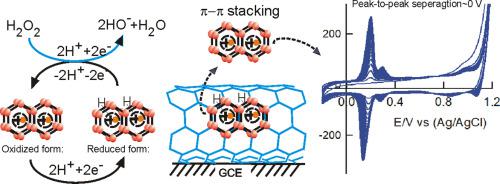当前位置:
X-MOL 学术
›
J. Electroanal. Chem.
›
论文详情
Our official English website, www.x-mol.net, welcomes your
feedback! (Note: you will need to create a separate account there.)
Highly redox-active organic molecular nanomaterials: Naphthalene and phenanthrene molecular species π-stacked MWCNT modified electrodes for oxygen-interference free H2O2 sensing in neutral pH
Journal of Electroanalytical Chemistry ( IF 4.1 ) Pub Date : 2020-12-01 , DOI: 10.1016/j.jelechem.2020.114680 Sivakumar Nisha , Annamalai Senthil Kumar
Journal of Electroanalytical Chemistry ( IF 4.1 ) Pub Date : 2020-12-01 , DOI: 10.1016/j.jelechem.2020.114680 Sivakumar Nisha , Annamalai Senthil Kumar

|
Abstract Electrochemical detection of Hydrogen peroxide in neutral pH is an important analytical problem that has been often worked out using horseradish peroxide (HRP) enzyme coupled with organic redox-active molecules as a transducer, and metallic systems in the form of metal nanoparticles and complexes chemically modified electrodes. Owing to non-amenable characteristic, direct electrochemical oxidation/reduction of H2O2 by redox-active organic molecules has been rarely described in the literature. Herein, we report naphthalene (NaP) and phenanthrene (PhenE) moieties immobilized MWCNT as advanced organic nanomaterial systems for enzyme-free, selective (dissolved oxygen, cysteine, citric acid, ascorbic acid, uric acid and glucose-interference free) and direct electrocatalytic reduction and sensing of H2O2 in neutral pH. These new organic-materials have been prepared by multiwall carbon nanotube (MWCNT) surface-bound electrochemical oxidation of NaP and PhenE at ~1.2 V vs Ag/AgCl in pH 2 KCl-HCl solution. The “as prepared” organic molecular materials showed a highly symmetrical voltammetric signal in cyclic voltammetric technique (peak-to-peak separation potential, ΔEp = 10 mV at scan rate = 10 mV s−1) and proton-coupled electron-transfer in characteristic. These new materials were characterized using several physicochemical techniques such as FTIR and Raman spectroscopes, transmission electron-microscope and electrochemical characterization (using radical quenching molecular system, 2,2,6,6-tetramethylpiperidin-1-yl)oxidanyl (TEMPO)). From the collective experimental results, it has been revealed that cationic radical species like organic molecules are stabilized on the organic nanomaterial modified electrode surface (via strong π-π interaction) and showed the redox peak. Amperometric i-t responses of the modified electrodes showed a systematic variation in the H2O2 detection current signal with current linearity in a range of 25–300 μM. Calculated current sensitivities and regression coefficient values are 4.8 nA μM−1 and 0.9996 with NaP-Redox and 4.20 nA μM−1 and 0.9994 with PhenE-Redox systems, respectively.
中文翻译:

高氧化还原活性有机分子纳米材料:萘和菲分子种类 π 堆叠 MWCNT 修饰电极,用于在中性 pH 值下进行无氧干扰 H2O2 传感
摘要 在中性 pH 条件下过氧化氢的电化学检测是一个重要的分析问题,经常使用辣根过氧化物 (HRP) 酶与有机氧化还原活性分子偶联作为换能器,以及以金属纳米颗粒和化学配合物形式存在的金属系统。修饰电极。由于不可抗力的特性,文献中很少描述氧化还原活性有机分子对 H2O2 的直接电化学氧化/还原。在此,我们报告了固定化多壁碳纳米管的萘 (NaP) 和菲 (PhenE) 部分作为先进的有机纳米材料系统,用于无酶、选择性(无溶解氧、半胱氨酸、柠檬酸、抗坏血酸、尿酸和葡萄糖干扰)和直接电催化H2O2 在中性 pH 值下的还原和传感。这些新的有机材料是通过多壁碳纳米管 (MWCNT) 表面结合的 NaP 和 PhenE 在 pH 2 KCl-HCl 溶液中以~1.2 V vs Ag/AgCl 的电化学氧化制备的。“制备的”有机分子材料在循环伏安技术中显示出高度对称的伏安信号(峰峰值分离电位,扫描速率 = 10 mV s−1 时 ΔEp = 10 mV)和质子耦合电子转移特性. 这些新材料使用多种物理化学技术进行表征,例如 FTIR 和拉曼光谱、透射电子显微镜和电化学表征(使用自由基猝灭分子系统,2,2,6,6-四甲基哌啶-1-基)氧烷基(TEMPO)。从集体实验结果来看,研究表明,有机分子等阳离子自由基物种稳定在有机纳米材料修饰的电极表面(通过强 π-π 相互作用)并显示出氧化还原峰。改良电极的电流响应显示 H2O2 检测电流信号的系统变化,电流线性范围为 25-300 μM。计算的电流灵敏度和回归系数值分别为 4.8 nA μM-1 和 0.9996(使用 NaP-Redox),以及 4.20 nA μM-1 和 0.9994(使用 PhenE-Redox 系统)。
更新日期:2020-12-01
中文翻译:

高氧化还原活性有机分子纳米材料:萘和菲分子种类 π 堆叠 MWCNT 修饰电极,用于在中性 pH 值下进行无氧干扰 H2O2 传感
摘要 在中性 pH 条件下过氧化氢的电化学检测是一个重要的分析问题,经常使用辣根过氧化物 (HRP) 酶与有机氧化还原活性分子偶联作为换能器,以及以金属纳米颗粒和化学配合物形式存在的金属系统。修饰电极。由于不可抗力的特性,文献中很少描述氧化还原活性有机分子对 H2O2 的直接电化学氧化/还原。在此,我们报告了固定化多壁碳纳米管的萘 (NaP) 和菲 (PhenE) 部分作为先进的有机纳米材料系统,用于无酶、选择性(无溶解氧、半胱氨酸、柠檬酸、抗坏血酸、尿酸和葡萄糖干扰)和直接电催化H2O2 在中性 pH 值下的还原和传感。这些新的有机材料是通过多壁碳纳米管 (MWCNT) 表面结合的 NaP 和 PhenE 在 pH 2 KCl-HCl 溶液中以~1.2 V vs Ag/AgCl 的电化学氧化制备的。“制备的”有机分子材料在循环伏安技术中显示出高度对称的伏安信号(峰峰值分离电位,扫描速率 = 10 mV s−1 时 ΔEp = 10 mV)和质子耦合电子转移特性. 这些新材料使用多种物理化学技术进行表征,例如 FTIR 和拉曼光谱、透射电子显微镜和电化学表征(使用自由基猝灭分子系统,2,2,6,6-四甲基哌啶-1-基)氧烷基(TEMPO)。从集体实验结果来看,研究表明,有机分子等阳离子自由基物种稳定在有机纳米材料修饰的电极表面(通过强 π-π 相互作用)并显示出氧化还原峰。改良电极的电流响应显示 H2O2 检测电流信号的系统变化,电流线性范围为 25-300 μM。计算的电流灵敏度和回归系数值分别为 4.8 nA μM-1 和 0.9996(使用 NaP-Redox),以及 4.20 nA μM-1 和 0.9994(使用 PhenE-Redox 系统)。











































 京公网安备 11010802027423号
京公网安备 11010802027423号